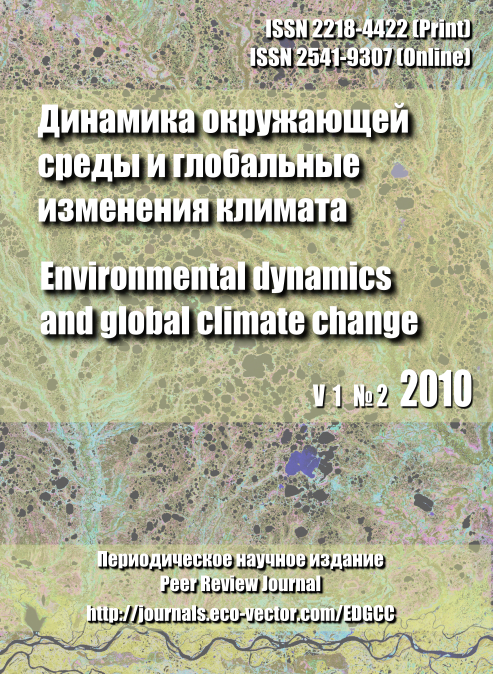Phytomass and primary production of mire ecosystemsin Surgut Polesie
- Authors: Kosykh N.P.1, Koronatova N.G.1
-
Affiliations:
- Учреждение Российской Академии наук Институт почвоведения и агрохимии СО РАН
- Issue: Vol 1, No 2 (2010)
- Pages: 4-
- Section: Articles
- Published: 15.06.2010
- URL: https://edgccjournal.org/EDGCC/article/view/6464
- DOI: https://doi.org/10.17816/edgcc124-
- ID: 6464
Cite item
Full Text
Abstract
Quantitative characteristic of biological productivity for most waterlogged region of Western Siberia, Surgut Polesie, is presented in the paper. The field work was carried out in two sites presented oligotrophic (ombrotrophic) mires: Tor and Federovskoe. Both sites included upland (ridges, and raised bog with pine - ryams) and lowland (hollows) mire ecosystems. Sphagnum fuscum-dwarf shrubs-pine plant community was in the ridges and the ryam and sphagna- sedge or sphagna-cotton grass community - in the hollows. Values of net primary production in oligotrophic ecosystems of Surgut Polesie were similar and sufficiently high and reached 530-630 g∙m-2∙year-1 depending on the topography and location of mires and does not depend on the value of living phytomass. In contrast to net primary production, value of total phytomass was significantly higher in upland mire ecosystems than in lowland ones: 2500-3500 g∙m-2 in the ridges and the ryam and 1010-1250 g∙m-2 in the hollows. The contribution of trees on upland elements of microrelief was from 30% to 40% of total living phytomass and 11-16% of net primary production of mire ecosystems. In above-ground sphere the main contribution in net primary production belongs to mosses in the all ecosystems as well as foliage of dwarf shrubs in the upland ecosystems, in below-ground sphere - roots of dwarf shrubs, trees and grass, and rhizomes of grass. In above-ground sphere the greatest phytomass value was obtained for perennial wooden parts of trees in upland ecosystems and for mosses in hollows, in below-ground sphere - for all plant fractions in upland ecosystems and for roots and rhizomes of grass in lowland ecosystems.
About the authors
Natal'ya Pavlovna Kosykh
Учреждение Российской Академии наук Институт почвоведения и агрохимии СО РАН
Author for correspondence.
Email: kosykh@issa.nsc.ru
Учреждение Российской Академии наук Институт почвоведения и агрохимии СО РАН
Natal'ya Gennad'evna Koronatova
Учреждение Российской Академии наук Институт почвоведения и агрохимии СО РАН
Email: coronat@mail.ru
Учреждение Российской Академии наук Институт почвоведения и агрохимии СО РАН
References
- Базилевич Н.И. 1967. Продуктивность и биологический круговорот в моховых болотах Южного Васюганья // Растительные ресурсы. Т. 3. Вып. 4. С. 567-589.
- Глаголев М.В. 2008. Эмиссия метана: идеология и методология «стандартной модели» для Западной Сибири // Динамика окружающий среды и глобальные изменения климата: Сборник научных трудов кафедры ЮНЕСКО Югорского государственного университета. Вып. 1 / Под ред. Глаголев М.В., Лапшина Е.Д. Новосибирск: НГУ. С. 176-190. Также доступна по URL: <http://www.ugrasu.ru/international/unesco/publications/journal/documents/Sbornic.pdf> (дата обращения: 04.03.2010).
- Глебов Ф.З. 1988. Взаимоотношения леса и болота в таежной зоне. Н.: Наука. Сиб. отд-е. 184 с.
- Ефремов С.П., Ефремова Т.Т., Блойтен В. 2005. Биологическая продуктивность и углеродный пул фитомассы лесных болот Западной Сибири // Сибирский экологический журнал. Т. 1. С. 29-44.
- Ильина И.С., Лапшина Е.Н., Лавренко Н.Н. и др. 1985. Растительный покров Западно-Сибирской равнины. Новосибирск: Наука. 251 с.
- Косых Н.П., Махатков И.Д. 2008. Структура растительного вещества в лесоболотных экосистемах средней тайги Западной Сибири // Вестник ТГПУ. Вып. 4 (78). Сер.: биологические науки. С. 77-80.
- Титлянова А.А. 1988. Методология и методы изучения продукционно-деструкционных процессов в травяных экосистемах / Титлянова А.А., Базилевич Н.И., Снытко В.А. и др. Биологическая продуктивность травяных экосистем. Географические закономерности и экологические особенности. Новосибирск: Наука. Сиб. отд-е. С. 3-10.
- Молчанов А.А., Смирнов В.В. 1967. Методика изучения прироста древесных растений. М. 95 с.
- Пьявченко Н.И. 1967. Биологическая продуктивность и круговорот веществ в болотных лесах Западной Сибири // Лесоведение. Т. 3. С. 32-43.
- Пьявченко Н.И. 1985. Торфяные болота, их природное и хозяйственное значение. М.: Наука. 152 с.
- Романова Е.А. 1965. Краткая ландшафтно-морфологическая характеристика болот Западно-Сибирской низменности // Тр. Гос. гидролог.ин-та. Вып. 5. С.96-112.
- Титлянова А.А., Косых Н.П., Миронычева-Токарева Н.П. 2000. Прирост болотных растений // Сибирский экологический журнал. Т. 5. С. 653-658.
- Храмов А.А., Валуцкий В.И. 1977. Лесные и болотные фитоценозы Восточного Васюганья (структура и биологическая продуктивность). Новосибирск: Наука. Сиб. отд-ние. 222 с.
- Шумилова Л.В. 1971. Типы болот // Атлас Тюменской области. Москва-Тюмень.
- Kosykh N.P., Mironycheva-Tokareva N.P., Parshina E.K. 2009. The carbon and macroelements budget in the bog ecosystems of the middle taiga in Western Siberia // International Journal of Environmental Studies. Vol. 66. P. 485-493.
- Kosykh N.P., Mironycheva-Tokareva N.P., Peregon A.M., Parshina E.K. 2008. Net primary production in peatlands of middle taiga region in western Siberia // Russian Journal of Ecology. V.39. № 7. Р.466-474.
- Kosykh N.P., Koronatova N.G., Naumova N.B., Titlyanova A.A. 2008. Above- and below-ground phytomass and net primary production in boreal mire ecosystems of Western Siberia // Wetlands Ecology and Management. V.16. P.139-153.
Supplementary files










